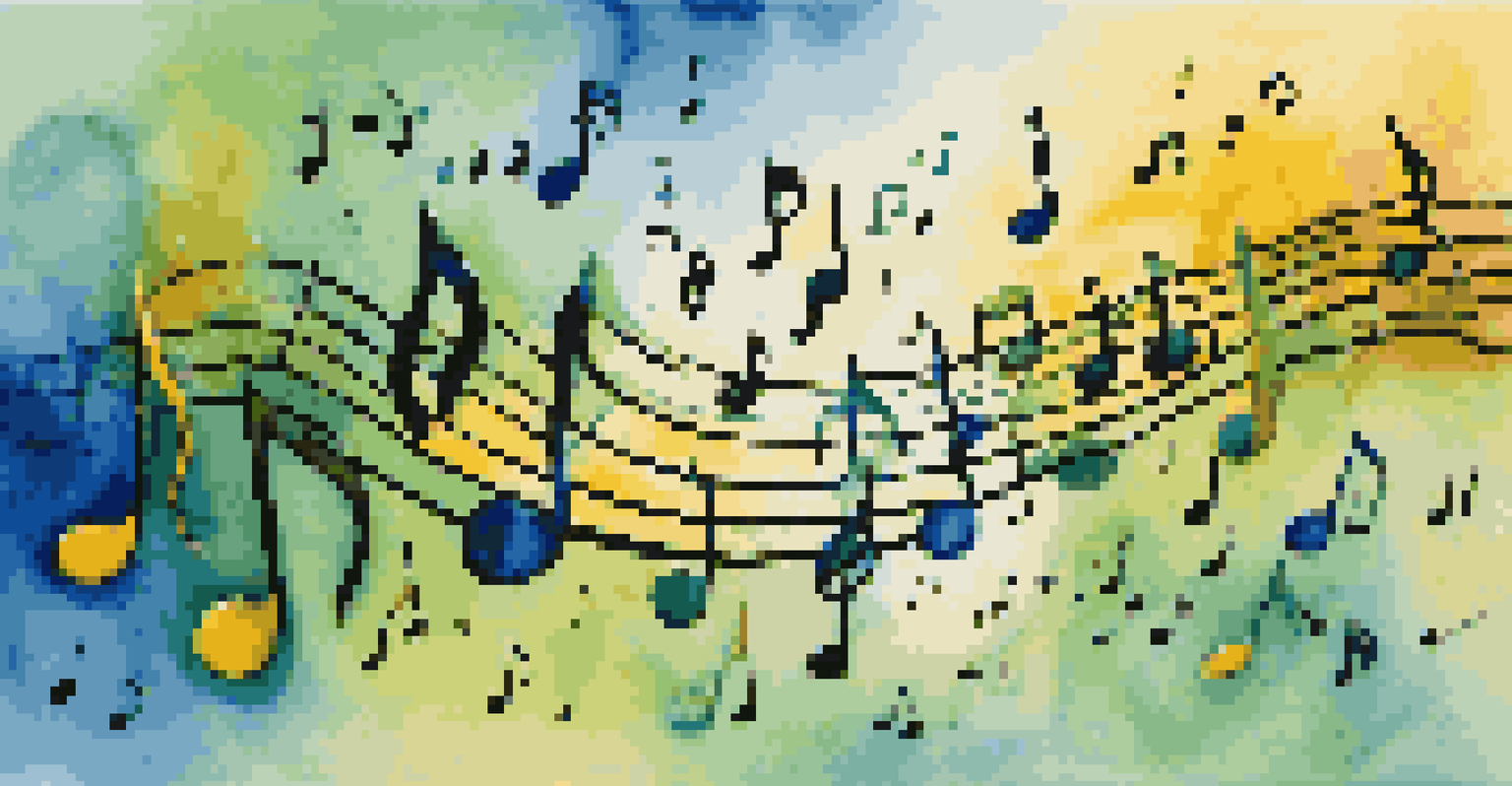The Impact of Rhythm on Melody: Analyzing Musical Structures

Understanding Rhythm: The Backbone of Music
Rhythm is often described as the heartbeat of music, providing the tempo and structure that give a song its unique feel. Just like a pulse, rhythm helps to organize sounds in time, influencing how melodies are perceived and enjoyed. It serves as a framework that supports the melody, ensuring that each note resonates with listeners.
Music is the shorthand of emotion.
Without rhythm, melodies would lack direction and coherence, resembling a scattered collection of notes rather than a harmonious composition. Think of rhythm as the scaffolding that holds up a beautiful building; without it, the structure might collapse. This fundamental aspect of music is what makes us tap our feet or sway our bodies to a song.
In essence, rhythm is not just about beats; it encompasses patterns, accents, and the overall flow of music. This rhythmic foundation sets the stage for melodic development, allowing composers to weave intricate musical stories that captivate audiences.
Melody: The Soul of Musical Expression
Melody can be considered the soul of any musical piece, often evoking emotions and memories in listeners. It is the sequence of notes that creates a recognizable tune, often the part we hum or sing along to. While rhythm lays the groundwork, melody brings the music to life, adding character and emotional depth.

Think of a memorable song; it’s usually the melody that sticks in your mind long after the music has stopped playing. This is because melodies often convey feelings in a way that connects deeply with our experiences. A soaring melody can inspire joy, while a descending one may evoke sadness, showcasing the emotional power of this musical element.
Moreover, melodies often rise and fall in pitch, creating a dynamic that engages listeners. When paired with a strong rhythm, a melody can create a captivating interplay, drawing people into the music and inviting them to experience the emotions conveyed by the notes.
The Interplay Between Rhythm and Melody
The relationship between rhythm and melody is akin to a dance; they move together, complementing each other to create a cohesive musical experience. When rhythm and melody work in harmony, they enhance the overall impact of a piece, making it more engaging and memorable. This synergy is what makes certain songs resonate with listeners on a profound level.
Rhythm is the soul of the music.
For instance, consider a lively folk tune where the rhythm is upbeat and the melody is bright. The rhythm encourages movement, while the melody adds a playful character, resulting in a song that invites people to join in and celebrate. Conversely, in a slow ballad, the rhythm may be more subdued, allowing a heartfelt melody to shine through, drawing listeners into a reflective mood.
This dynamic interaction ensures that neither element overshadows the other. Instead, they work together to create a rich tapestry of sound that captures the listener's attention and evokes an emotional response.
Rhythm's Role in Melodic Variation
Rhythm plays a crucial role in the variation of melodies, allowing composers to explore different moods and styles. By altering the rhythm of a melody, a musician can transform its emotional impact, making it feel fresh and dynamic. This is often seen in genres like jazz, where improvisation leads to spontaneous rhythmic changes that breathe new life into familiar tunes.
For example, a simple melody can take on a completely different character when played with syncopated rhythms, which emphasize unexpected beats. This shift can create tension and excitement, inviting listeners to experience the music in new ways. Such variations not only keep the audience engaged but also showcase the versatility of the melody itself.
In this way, rhythm acts as a tool for creative expression, enabling musicians to break free from traditional patterns and explore innovative sounds. It encourages experimentation, allowing artists to push the boundaries of melody and create unique musical experiences.
Cultural Influences on Rhythm and Melody
Cultural background plays a significant role in shaping the relationship between rhythm and melody in music. Different cultures have distinct musical traditions that influence how rhythms and melodies are constructed and perceived. For instance, African music often features complex polyrhythms, while Western classical music tends to emphasize harmonic progressions and structured melodies.
These cultural differences can lead to unique musical expressions that highlight the interplay between rhythm and melody. In Latin music, for example, the infectious rhythms often drive the melody forward, creating an irresistible urge to dance. This cultural fusion showcases how rhythm can enhance a melody's appeal, making it resonate with audiences across different backgrounds.
Moreover, as music continues to evolve, the blending of various cultural influences leads to new forms of expression. This cross-pollination enriches the musical landscape, allowing rhythm and melody to interact in innovative ways, producing exciting and diverse sounds that reflect our shared human experience.
Analyzing Musical Structures: A Deeper Look
To truly appreciate the impact of rhythm on melody, one can analyze the structures of various musical pieces. This involves breaking down songs to understand how rhythm complements the melodic lines. By listening closely, you can identify how changes in rhythm alter the feel of the melody, revealing the artistry behind the composition.
For instance, in a classical symphony, the conductor often uses tempo changes to highlight different themes, demonstrating the importance of rhythm in shaping the overall narrative. By observing how rhythm interacts with melody, listeners can gain a deeper appreciation for the composer's intent and the emotional journey of the music.
This analytical approach not only enhances our listening experience but also inspires aspiring musicians to experiment with their own compositions. By understanding these structures, they can craft melodies that are not only memorable but also rhythmically engaging.
Conclusion: The Harmonious Relationship of Rhythm and Melody
In conclusion, rhythm and melody are intricately linked, each enhancing the other to create compelling musical experiences. Understanding the impact of rhythm on melody can deepen our appreciation for music and its emotional power. This relationship is a testament to the creativity and rhythmical complexity that musicians bring to their craft.
As we explore and analyze music, we discover how rhythm can transform a simple melody into a captivating piece that resonates with listeners. By recognizing this interplay, we can better appreciate the artistry involved in music creation and the profound emotions it can evoke.

Ultimately, the harmonious relationship of rhythm and melody invites us to engage with music on a deeper level, encouraging us to explore, connect, and express ourselves through the universal language of sound.